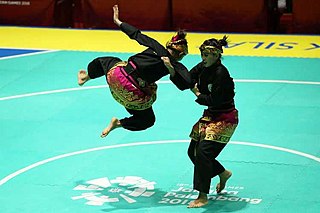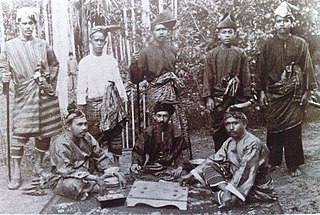
Silat Melayu, also known as Seni Persilatan Melayu or simply Silat, is a combative art of self-defence from the Malay world, that employs langkah ('steps') and jurus ('movements') to ward off or to strike assaults, either with or without weapons. Silat traced its origin to the early days of Malay civilisation, and has since developed into a fine tradition of physical and spiritual training that embodies aspects of traditional Malay attire, performing art and adat. The philosophical foundation of modern Malay Silat is largely based on the Islamic spirituality. Its moves and shapes are rooted from the basis of Silat movements called Bunga Silat, and Silat performances are normally accompanied with Malay drum assembles.

Kuntao or kuntau is a Hokkien term for the martial arts of the Chinese community of Southeast Asia, specifically the Malay Archipelago. It is most commonly practiced in and associated with Indonesia, Malaysia, the Philippines and Singapore.

Sparring is a form of training common to many combat sports. Although the precise form varies, it is essentially relatively 'free-form' fighting, with enough rules, customs, or agreements to minimize injuries. By extension, argumentative debate is sometimes called sparring.

The chain whip, also known as the soft whip, is a weapon used in some Chinese martial arts, particularly traditional Chinese disciplines, in addition to modern and traditional wushu. It consists of several metal rods, which are joined end-to-end by rings to form a flexible chain. Generally, the whip has a handle at one end and a metal dart, used for slashing or piercing an opponent, at the other. A cloth flag is often attached at or near the dart end of the whip and a second flag may cover the whip's handle. The flag or flags adds visual appeal and produces a rushing sound as the whip swings through the air. The rushing noise also helps the user with identifying the location of the other end, since the weapon moves too fast to be normally noticed by human eyes.

Pencak silat is an umbrella term for a class of related Indonesian martial arts. In neighbouring countries, the term usually refers to professional competitive silat. It is a full-body fighting form incorporating strikes, grappling and throwing in addition to weaponry. Every part of the body is used and subject to attack. Pencak silat was practiced not only for physical defense but also for psychological ends. There are hundreds of different pencak silat styles and schools which tend to focus either on strikes, joint manipulation, weaponry, or some combination thereof.

An elbow strike is a strike with the point of the elbow, the part of the forearm nearest to the elbow, or the part of the upper arm nearest to the elbow. Elbows can be thrown sideways similarly to a hook, upwards similarly to an uppercut, downwards with the point of the elbow, diagonally or in direct movement and in several other ways, like during a jump. Elbow strikes are native to the traditional Southeast Asian martial arts, traditional Chinese martial arts and traditional Okinawan martial arts.
The Liu Seong System is one of the many styles of Kuntao, which are hybrid martial arts systems derived from the cultures of Chinese Indonesia. The Liu Seong system was brought to America, from Indonesia, by Willem A. Reeders (1917-1990).

Footwork is a martial arts and combat sports term for the general usage of the legs and feet in stand-up fighting. Footwork involves keeping balance, closing or furthering the distance, controlling spatial positioning, and/or creating additional momentum for strikes.
Personal names in Malaysia vary greatly according to ethno-cultural group. Personal names are, to a certain degree, regulated by the national registration department, especially since the introduction of the National Registration Identity Card (NRIC).
Seni Gayong is a style of silat from Malaysia. It was the first martial arts association to be registered in the country, and is now the biggest and most internationally known Malaysian silat discipline. Gayong is overseen by the Pertubuhan Silat Seni Gayong Malaysia (PSSGM) or the Malaysian Silat Seni Gayong Organisation. This organisation is currently led by Dato' Ismail Jantan. While it is most popular in Malaysia and Singapore, there are also branches in Vietnam, Australia, France, Kuwait, Tunisia, Britain, and the United States.
Tan Sri Dato' Seri Hadi Awang(Jawi: عبدالهادي بن اواڠ; born 20 October 1947) is a Malaysian politician and religious teacher who has served as Member of Parliament (MP) for Marang since October 1990, 7th President of the Malaysian Islamic Party (PAS), an Islamist political party and a component party of Perikatan Nasional (PN) coalition, since July 2002. He served as Leader of the Opposition from July 2002 to March 2004, Menteri Besar of Terengganu from December 1999 to March 2004 and Member of the Terengganu State Legislative Assembly (MLA) for Ru Rendang from 1986 until 2018. At the international level, he also serves as vice-president of the International Union of Muslim Scholars.

Silat is the collective term for a class of indigenous martial arts from the Nusantara and surrounding geocultural areas of Southeast Asia. It is traditionally practised in Brunei, Indonesia, Malaysia, Singapore, Southern Thailand, Southern Philippines and Southern Vietnam. There are hundreds of different styles (aliran) and schools (perguruan) which tend to focus either on strikes, joint manipulation, weaponry, or some combination thereof.

The International Pencak Silat Federation (IPSF) or PERSILAT, which was founded in Jakarta on 11 March 1980, is the only international Pencak Silat organization in the world. The International Pencak Silat Federation (IPSF) is the largest international governing body of competitive pencak silat with 66 member countries. IPSF is the only pencak silat organization recognised by the Olympic Council of Asia and has more than five million members. The IPSF organizes the Junior and Senior World Pencak Silat Championships, which are each held every other year. The President of the IPSF is Prabowo Subianto, and the headquarters are located in TMII, Jakarta, Indonesia.
Silat Patani is a style of silat originating in the Pattani kingdom, now a state of Thailand. It is primarily practiced in northern Malaysia and southern Thailand. The art is also known as silat tua because tradition credits it as the oldest form of silat Melayu. It is sometimes called silat tua Yawi, being the Thai-Malay pronunciation of Jawi in this case referring to the Thai Malay community. These two latter names are increasingly popular among Malaysian practitioners, so as not to acknowledge the Pattani origin of the art.

Riau-Lingga Sultanate, also known as the Lingga-Riau Sultanate, Riau Sultanate or Lingga Sultanate was a Malay sultanate that existed from 1824 to 1911, before being dissolved following Dutch intervention.

Indonesian martial arts includes a variety of fighting systems native to or developed in the archipelago of Indonesia, both the age-old traditional arts, and the more recently developed hybrid combatives. In the Indonesian language the term bela-diri is used to mean martial art, and in essence the Indonesian fighting arts are meant as one's defence against perceived threat and assault. Other than physical training, they often include spiritual aspects to cultivate inner strength, inner peace and higher psychological ends.
Sri Paduka Dato' Bendahara Sri Maharaja Tun Ali ibni Almarhum Dato' Bendahara Paduka Raja Tun Koris was the 23rd and the last Bendahara of Johor Sultanate, and the fourth Raja Bendahara of the Pahang Kingdom who reigned from 1806 to 1857.

Pahang Malays are a sub-group of Malay people native to the state of Pahang, in the east coast of Peninsular Malaysia. With population of approximately 1.08 million people, they constitutes 70% of Pahang state's population, making them the dominant ethnic group in the state. Their language, Pahang Malay is one of many Malayan languages spoken in the region that belong to the Malayo-Polynesian group of Austronesian family.
Beksi Silat is one of the most popular traditional martial arts of the Betawinese. This kuntao-silat hybrid style was originally developed in Kampung Dadap, a village in Kosambi district of Tangerang Regency, Banten Province, Indonesia. The founder of this style combined elements of his ancestral Chinese martial arts with the silat knowledge he received from his Betawi teachers. The style spread through his disciples to the coastal Betawinese and the Benteng Chinese around Kampung Dadap. Eventually, the silat style also reached Petukangan Selatan in South Jakarta and Batujaya in Tangerang.
Cingkrik Silat is one of the traditional pencak silat styles of the Betawinese. This style originally came from the Rawa Belong area, which is now part of the Kebon Jeruk subdistrict, West Jakarta, Indonesia. This style was created by Ki Maing around the 1920s. Cingkrik Silat has now been spread to various places in Jakarta through many silat schools opened by its practitioners.











